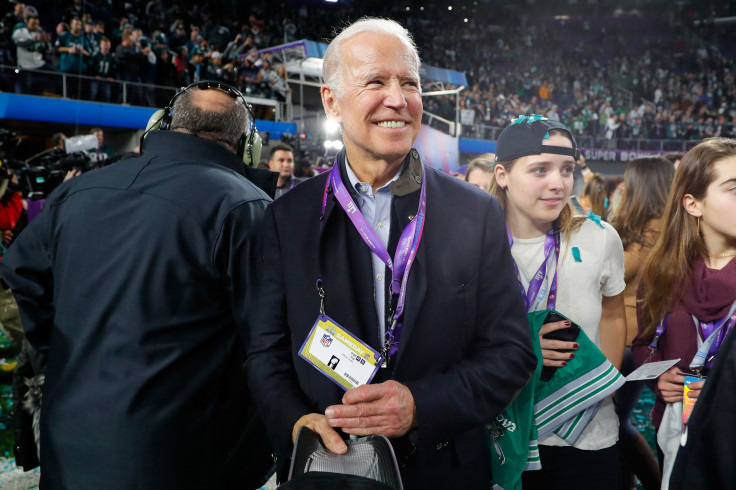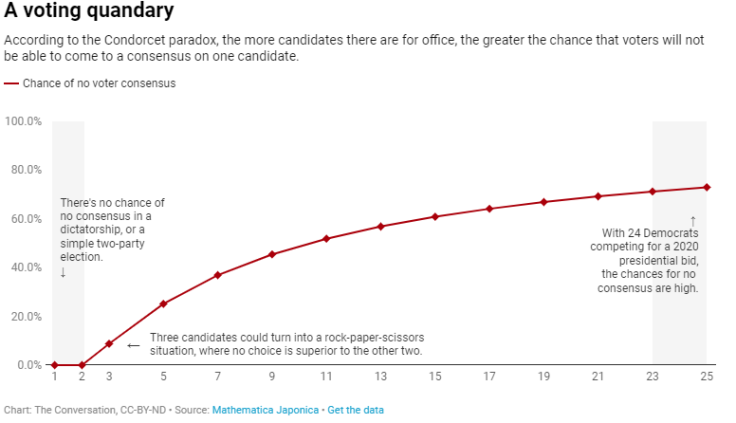Math Explains Why The Democrats May Have Trouble Picking A Candidate

With 24 declared candidates for the Democratic Party’s presidential nomination (and counting), many Americans are likely wondering how the party will ultimately make up its mind and settle on the best candidate.
As mathematicians, we wondered whether there might not even be a best candidate. In fact, this is an established mathematical paradox. The more candidates there are, the greater the chance there is no clear favorite.
Here’s what we mean.
Suppose there were only two candidates for some office, and that each voter preferred one or the other. Barring a perfect tie, one candidate will end up with the most votes. Ignoring complications like the Electoral College or voter turnout, the election process provides a way to measure the “will of the people.”
Now imagine there were three candidates instead of just two.
Three friends and a pollster walk into a bar and discuss the upcoming election. The first friend thinks that candidate A is better than B, and that C is the worst of all. The next agrees that B is better than C, but she thinks that B and C are both better than A. The final friend partially agrees with both of them: He thinks C is the best candidate, followed by A, and then B.
The pollster cannot say which is the best candidate, since, for these voters, there is no best candidate! Their ranked preferences are inconsistent with each other.
This situation is an example of Condorcet’s paradox. It was named for the French Enlightenment philosopher and mathematician Marie Jean Antoine Nicolas de Caritat, marquis of Condorcet, an advocate of democratic reforms who perished in 1794, a victim of the French Revolution.
To Condorcet, a winner is a candidate who would win a one-on-one election against any other candidate. But, a paradox arises when there is no candidate who wins head-to-head against all opponents – which implies that voters’ ranked preferences contradict one another.
How likely is a situation like Condorcet’s paradox to arise in practice? It depends on how many candidates there are, and how evenly distributed the voters’ preferences are.
Relatively few studies have shown conclusive evidence for the Condorcet paradox in real life. But it has been observed in a number of elections, including the 2006 Danish elections for prime minister.
The possibility is not as abstract as it may seem. For example, some Americans, including Bernie Sanders, believe that, had Sanders won the Democratic primary in 2016, he would have beat PJT: would have beaten? Trump in the general election. This implies an underlying rock/paper/scissors inconsistency: Trump beats Clinton; Clinton beats Sanders; but, somehow, Sanders beats Trump.
In a three-candidate race, there are six possible ways of ranking them. There is at least a 9% chance the electorate as a whole has no clear preference. PJT: For three candidates, the chance is 8.77% Saying “at least a 9% chance” is wrong, since it’s actually less than 9%. Better to say “about a 9% chance” instead (original wording).
With 24 different candidates running, there are 620 billion trillion possible rankings. A study by University of Delaware researcher William V. Gehrlein calculated the probability that there is no Condorcet winner, a candidate who would win a one-on-one election against any other candidate. With two dozen candidates, there will be no Condorcet winner 70% of the time.
That means that, about two-thirds of the time, there will be at least three candidates who end up in a winnerless rock-paper-scissors situation.

Condorcet’s paradox assumes a worst-case scenario, where the candidates are statistically indistinguishable from one another. In this situation, each voter arrives at their rank order randomly and independently – as if each voter secretly rolls the dice to rank the candidates.
It is unlikely that voters’ preferences are actually chosen in this random way. For example, Joe Biden might take affront to the notion that he is equally likely to be ranked first or last across all Democrats’ ballots.
Nevertheless, if Democrats appear to be having difficulty making up their collective mind this election season, it is possible that this apparent indecision is because there is no well-defined will of the people to be discerned at all.
Alexander Strang is a Ph.D Candidate in Mathematics at Case Western Reserve University, and Peter Thomas is Professor of Mathematics at Case Western Reserve University.
Disclosure statements:
Alexander Strang receives funding from the National Science Foundation. Peter Thomas receives funding from the National Science Foundation.
This article originally appeared in The Conversation. Read the article here.





















